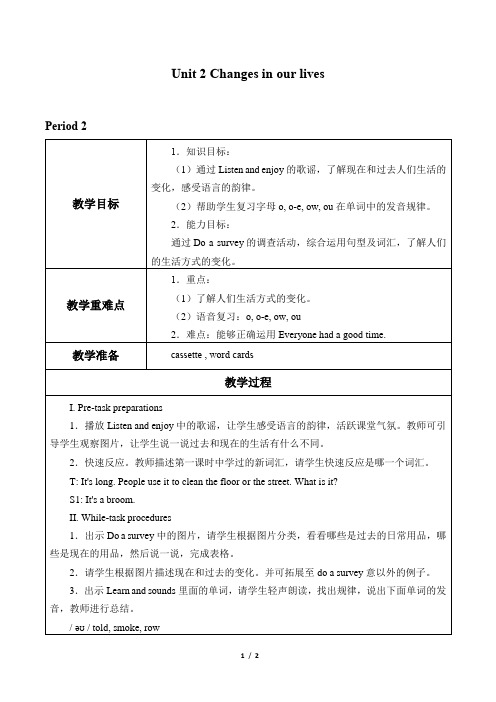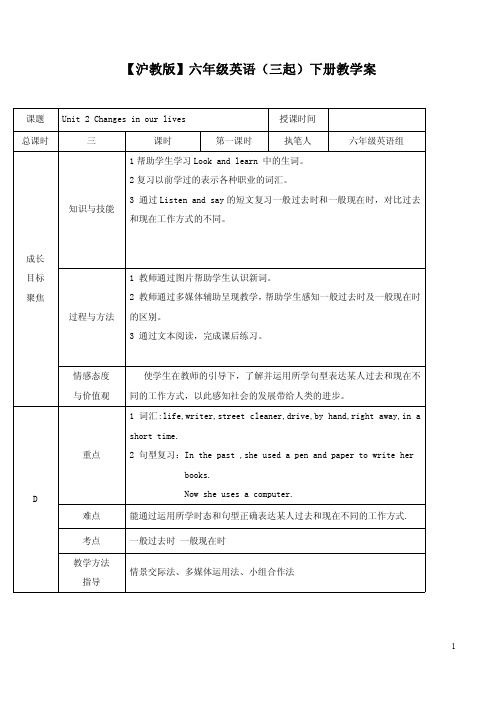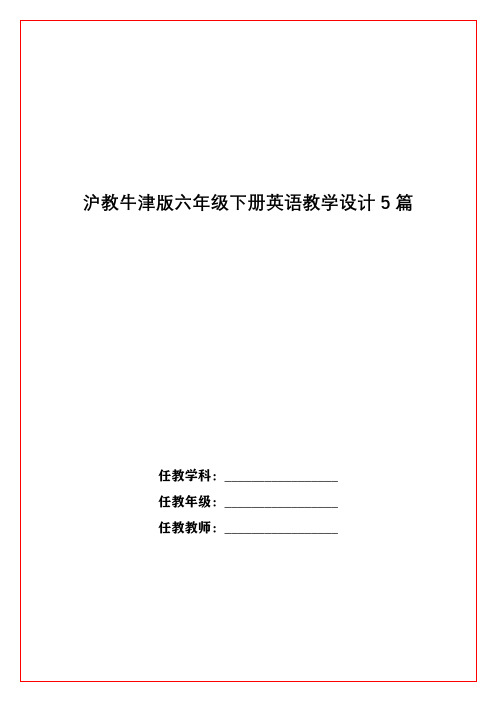沪教版小学英语六年级下册全册教案
沪教版本小学六年级的英语下教学设计课件课件

最新沪教版六年级英语下教学设计M1 Changes and differencesUnit1 You and me教学内容与目标教学内容功描述,询问● 询问身高及体重。
能● 描述差异语核心句型和●I ’m 150 centimeters tall.言日常用语●I usually play football after school.知●There are a lot of tall buildings in the city.识●How exciting!●That ’s fantastic!词汇Weigh, kilogram, centimeter,fan, theatre, go fishing,enjoyoneself语音a, a-e, ai, ay, eigh, i, i-e, y, igh,ie语听● 听懂谈论彼此身高体重和课余生活的对话。
言说● 用恰当的句型说说自己的身高、体重,介绍自己的课余生活技●用 There be 句型说说自己居住的环境。
能读● 读懂关于彼此身高、体重及课余生活差异的对话。
● 读懂关于城市与乡村差异的短文。
写● 能结合语境用正确的句子写写个人情况和生活环境。
教学目标● 能在语境中正确运用本单元的核心词汇,复习已学过的核心词。
● 能用用恰当的句型说说自己的身高、体重,介绍自己的课余生活,说说自己居住的环境●根据字母 a, a-e, ai, ay, eigh, i, i-e, y, igh,ie的发音规律,能拼读简单的单词。
● 能理解和尊重来自不同文化背景的人。
教学重点:●词汇: Weigh, kilogram, centimeter, fan, theatre, go fishing, enjoy oneself●句型: I ’m 150 centimeters tall. I usually play football after school.There are a lot of tall buildings in the city. How exciting! That’s fantastic!●字母 a, a-e, ai, ay, eigh, i, i-e, y, igh,ie教学点:一般在 be 、 do 和there be 在中的音。
沪教版三年级起点小学六年级英语下册教案Unit 2 Changes in our lives_教案2

3.出示Learn and sounds里面的单词,请学生轻声朗读,找出规律,说出下面单词的发音,教师进行总结。
/əʊ/told,smoke,row
/aʊ/house,tower
III. Post-task activities
教学重难点
1.重点:
(1)了解人们生活方式的变化。
(2)语音复习:o,o-e, ow, ou
2.难点:能够正确运用Everyone had a good time.
教学准备
cassette , word cards
教学过程
I.Pre-task preparations
1.播放Listen and enjoy中的歌谣,让学生感受语言的韵律,活跃课堂气氛。教师可引导学生观察图片,让学生说一说过去和现在的生活有什么不同。
2.快速反应。教师描述第一课时中学过的新词汇,请学生快速反应是哪一个词汇。
T:It's long.People use it to clean the floor or the street.What is it?
S1:It's a broom.
II. While-task procedures
1.出示Do a survey中的图片,请学生根据图片分类,看看哪些是过去的日常用品,哪些是现在的用品,然后说一说,完成表格。
让学生查找一些本市若干年前的老照片。让学生根据人口、房屋、交通和生活等分类展开讨论,并整理成表格。
S1:In the past,there were very few cars in thecity.Nowmanypeople drive cars.
最新沪教版六年级英语下教学设计

[教学难点]
能正确运用句型。
用具准备
tape, word cards , pictures
教学过程
二次备课
前置性作业:listen to the tape
Pre-task preparatons
询问学生每天放学后的活动。
T: What do you usually do after school?
然后分别请两个高矮不一的学生站起来,教师问:Who is taller?请全班学生回答:
…is taller
播放对话录音,请学生逐句跟读,鼓励学生昼模仿录音中人物的语音语调。
教师读出反馈练习中的句子,请学生快速判断所描述的是Joe还是Georger的角色,有感情地朗读对话。教师在教室内来回巡视,如果学生有困难,及时给予帮助。
●There are a lot of tall buildings in the city.
●How exciting!
●That’s fantastic!
词汇
Weigh, kilogram, centimeter, fan, theatre, go fishing, enjoy oneself
语音
he ?
练习设计
Read P2
作业批改
记录
板书设计
U1 You and me
Weigh, kilogram, centimeter,
fan, theatre, go fishing,
句型:I’m 150 centimeters tall.
I usually play football after school.
S1: How much do you weigh?
【沪教版】六年级英语(三起)下册Unit 2 Changes in our lives教学案

【沪教版】六年级英语(三起)下册教学案课题Unit2Changes in our lives授课时间总课时三课时第一课时执笔人六年级英语组成长目标聚焦知识与技能1帮助学生学习Look and learn中的生词。
2复习以前学过的表示各种职业的词汇。
3通过Listen and say的短文复习一般过去时和一般现在时,对比过去和现在工作方式的不同。
过程与方法1教师通过图片帮助学生认识新词。
2教师通过多媒体辅助呈现教学,帮助学生感知一般过去时及一般现在时的区别。
3通过文本阅读,完成课后练习。
情感态度与价值观使学生在教师的引导下,了解并运用所学句型表达某人过去和现在不同的工作方式,以此感知社会的发展带给人类的进步。
D重点1词汇:life,writer,street cleaner,drive,by hand,right away,in ashort time.2句型复习:In the past,she used a pen and paper to write herbooks.Now she uses a computer.难点能通过运用所学时态和句型正确表达某人过去和现在不同的工作方式.考点一般过去时一般现在时教学方法指导情景交际法、多媒体运用法、小组合作法课标要求能正确运用句型表达并区别一般现在时和一般过去时。
精讲设计Step1Warming upa play games.b教师出示照片,帮助学生回忆已学职业名词.Step2Presentationa教师通过肢体语言及简笔画辅助教授新词。
b出示电子书,请学生观看动画,注意模仿并理解文本。
c教师出示本课时的知识重点及语法点,请学生小组合作,预习课文。
d教师针对本班学情,设计难易适当的问题,请学生带着问题思考朗读。
e请个别同学回答问题,以此检查学生自主阅读的情况。
f再次播放录音,学生跟读,鼓励学生注意模仿语音语调。
g学生自主完成课后练习,教师订正指导。
沪教牛津版六年级下册英语教学设计5篇

T: Look, what did David do on Sunday? (PPT2显示David 在看卡通片)
T: Yes, he watched cartoons. What else did he do ?
(PPT显示David在走向动物园,稍停,等待回答)
T: Now practice in pairs. (PPT3 显示一个男孩和一个女孩的活动,图下有时间和句型)
首先, 这是一个掷筛子的游戏,请根据图片顺序来解释一下游戏规则。
(PPT24--25 显示图片)
(学生尝试解释游戏规则)
2 T: 游戏规则就是象大家所描述的这样:
首先第一个同学根据所掷筛子的数字走棋子,并向第二个同学提问,如果第二个同学答对了就换成第二个同学掷筛子提问;如果答错了,第一个同学进行纠正,并继续掷筛子。
(稍等)
引导学生使用句型: Whose… is it/are they? It’s /They’re mine/his/hers/ours.
造句。复习第七单元名词性物主代词的用法。
(本步骤设计说明:本单元是综合复习,在本部分,教师安排对话、交流等形式复习旧知,为本课练习做铺垫。)
第二步:单元各板块综合练习
3 (出示PPT14--16核对正确答案,讲解易错部分)
(三) C Look, read and complete
1 T:刚才,我们练习的都是口头表达,下面我们来试试书面表达. Look!
(PPT17--19 显示各个单元重点句式中容易出错的地方,需要强调之处均为空白; 在引导学生自主归纳的基础上,出示PPT完整内容)
T: We know we can get some presents on Christmas day. And last year, on
沪教版小学六年级下册英语教案

【导语】英语教案设计是改善课堂教学的⼀种更⾼层次的探索,是提⾼课堂教学质量和效率的⼀项必要⼯作,它可以促进教学的系统化,使⽼师掌握讲课节奏。
以下是®⽆忧考⽹整理的《沪教版⼩学六年级下册英语教案》相关资料,希望帮助到您。
【篇⼀】沪教版⼩学六年级下册英语教案 ⼀、教学内容: 综合练习 ⼆、教学⽬标: 1、掌握形容词以及⽐较级的使⽤。
2、能听得懂、会说、会读和会拼写tall ,light ,young ,old ,heavy。
3、掌握会话中出现的三会单词和词组twin ,minute ,centimeter, child ,cute, also, chat. 4、能听得懂、会说、会读和会写四会句型:Who taller than David? Gao Shan is taller than David . 5、能听得懂、会说、会读⽇常交际⽤语. Whose bag is heavier ,yours or mine ? I'm as tall as you . SuYang is younger than Su Hai . 6、了解字母组合or在单词中的读⾳。
7、会说英语歌谣《Iwish Iwas taller.》 三、教学重、难点: 正确掌握B部分出现的四会单词light lighter , heavy heavier,和句型Who is taller ,you and SuYang? Whose ruler is longer ,yours or mine? 四、课前准备: 1、准备录⾳机和本课H部分的磁带 2 、练习题的投影⽚。
3 、课前写好本课的课题。
五、教学过程: A、跟⾳乐集体唱歌曲。
B、 1、Free talk. 师⽣交流 2、请学⽣之间⽤所学的句型问答,分组⽐赛 C、Revision 复习 1、看A部分投影⽚,创设情景让学⽣表演 2、让学⽣复述A部分第⼀段和会话。
【沪教版】六年级英语(三起)下册U6 PE lessons教学案
【沪教版】六年级英语(三起)下册教学案M2work and playU6PE lessons教学内容功能介绍,喜好●体育课上经常做的运动。
●介绍自己和他人喜欢的运动。
语言知识核心句型和日常用语●We have two PE lessons at school every week.●Sometimes we play ball games.●My friends and I like playing sport.●Enjoy your swimming lessons!词汇Long race,short race,win,long jump,high jump 语音Y,h,w,wh,l,r,rr语言技能听●听懂介绍体育课活动的短文。
说●能用一般现在时介绍体育活动。
读●读懂介绍体育课活动的短文。
●读懂游泳课注意事项的短文。
写●能结合语境写出正确的句子并简单介绍体育课的情况。
教学目标●能在语境中正确运用本单元的核心词汇。
●能用合适的句型介绍体育课的基本情况。
●根据字母Y,h,w,wh,l,r,rr的发音规律,能拼读简单的单词。
●能在运用英语知识完成任务的过程中,了解学校体育课的基本情况,热爱体育运动。
●能初步了解奥运会的基本知识,如五环标志等。
教学重点:●词汇:Long race,short race,win,long jump,high jump●句型:We have two PE lessons at school every week.Sometimes we play ball games.My friends and I like playing sport.Enjoy your swimming lessons!●了解字母Y,h,w,wh,l,r,rr在单词中的发音。
教学难点:●复杂句式,如:You should do warm-up exercises before you go into the water.●jump作动词和作名词的不同用法及搭配●like something与like doing,be good atsomething与be good at doing的不同用法。
小学英语沪教版六年级下册Word list 1全套教案模板范文
小学英语沪教版六年级下册Word list 1全套教案
模板范文
【比赛获奖教案】
1教学目标
知识与技能:
1、掌握be动词现在式的三种形式am,is,are
2、掌握be动词的肯定句、否定句和疑问句。
过程与方法:通过知识点及例句的讲解来掌握,再用练习加以巩固。
情感、态度与价值观:通过be动词的复习增强学生学习英语的信心。
2学情分析
be动词是我们必须掌握的一个知识点,虽然be动词少,但是由于其形式多变,给很多同学在学习时造成了一定的困难,为此就作一个be动词的专题复习,让学生熟悉be动词的用法。
3重点难点
教学重点:be动词的用法。
教学难点:be动词的肯定句、否定句和疑问句。
4教学过程
教学活动
1【练习】be动词
一、There be句型的结构
1. 定义:There be句型表示某处存在某物或某人。
2. 结构:(1) There is +单数可数名词/不可数名词+ 地点状语.
(2) There are +复数名词+地点状语.
二、There be结构中的动词be的确定
1. there be 结构中的谓语动词be在人称和数上应与其后的主
语保持一致。
主语是不可数名词或单数可数名词时用is,是复数时用
are。
如:
There is a table in the room.
房间里有一张桌子。
There is a little water in the bottle.
瓶子里有一点水。
There are some pens on the chair.。
【上海教育版】小学英语六年级下册:全册教案
1.能听说读写重点单词writer drive life photographer和短语street cleaner, in the past, in a short time , a digital camera, right away, street sweeper
2.能够运用“In the past, he/she ... Now he /she ...”正确描述他人的职业及其过去和现在的生活变化.
In the past, Mr Zhangusedfilm to take photos.Now heusesa digital camera.
In the past, Mr Yangsweptthe streets with a broom. Now hedrivesa streetsweeper.
3. Main sentences
⑴Fred and Doris smiled at each other.
⑵We are poor ,but we are happy.
⑶I wish you a happy life.
Step Three:Read the story again
Step Four:Complete the sentences on page 11
Phrases: enjoy themselves, at the weekend , a lot of tall buildings,
Plant crops ,getthe crops in
Sentences: There is\are ...
教学准备
Recorder
教学过程
Step One:Review
Module 1Changes and difference
沪教版三年级起点小学六年级英语下册教案Unit 2 Changes in our lives_教案3
1.出示过生日的图片,引出单词wish。
T:It'sS1's birthday.What's he/she doing?
S1:He/She's blowing out the candles.
S2:He/She's making a wish.
T:Yes.We can make a wish on our birthday.What do you wishfor?
1通过完成readstory的后续练习帮助学生学习理解文中信2通过学习任务帮助学生巩固和综合运用本单元所学的知识和技能描述自己班级的变化
Unit2 Changes in our lives
Period 3
教学目标
1.知识目标:
通过故事《快乐的农夫和他的妻子》提升学生的阅读能力,并帮助学生理解故事中的蕴含的道理。
S3: I want to2.引入Read a story中的人物。出示人物的图片。
3.引导学生默读课文,并回答问题。
4.学生分组演出故事。
III. Post-task activities
课堂讨论。让学生进行角色扮演,说一说如果自己能获得三个愿望,会想要什么。
2.能力目标:
(1)通过完成Read a story的后续练习,帮助学生学习理解文中信息。
(2)通过学习任务,帮助学生巩固和综合运用本单元所学的知识和技能,描述自己班级的变化。
3.情感目标:
培养学生热爱生活的情感。
教学重难点
1.重点:
(1)词汇学习:poor,wish
(2)句型复习:I'd like to give you three wishes.
- 1、下载文档前请自行甄别文档内容的完整性,平台不提供额外的编辑、内容补充、找答案等附加服务。
- 2、"仅部分预览"的文档,不可在线预览部分如存在完整性等问题,可反馈申请退款(可完整预览的文档不适用该条件!)。
- 3、如文档侵犯您的权益,请联系客服反馈,我们会尽快为您处理(人工客服工作时间:9:00-18:30)。
沪教版小学英语六年级下册全册教案目录Module1 Changes and differences《1 You and me》 (2)Module1 Changes and differences《2 Changes in our lives》 (9)Module1 Changes and differences《3 Our school in the future》 (12)Module1 Changes and differences《Project 1》 (15)Module 2 Work and play《4 Art》 (22)Module 2 Work and play《5 Crafts》 (26)Module 2 Work and play《6 PE lessons》 (30)Module 2 Work and play《Project 2》 (35)Module3 Things we do《7 Helping others》 (40)Module3 Things we do《8 Reading signs》 (43)Module3 Things we do《9 Reusing things》 (47)Module 4 Things we enjoy《10 Great storybooks》 (50)Module 4 Things we enjoy《11 Western festivals》 (53)Module 4 Things we enjoy《12 The five peas》 (57)《Word list 1》 (61)《Daily expressions》 (64)《Irregular verbs》 (67)Module1 Changes and differences《1 You and me》1教学目标1、能简单询问别人的长相,以及相关的具体个人信息,并能进行比较。
例如:What’s …like? How tall are you? How hea vy are you? How old are you?How long…? How bi g…?2、能听懂会说: I’m…than …. My …than your s…My …kg...My…cm long.等句子,并能在实际情景中运用。
2重点难点1、重点掌握形容词的比较级以及对个人信息咨询的句子。
2、难点比较级的归纳和在情景中的应用。
3教学过程教学活动1【导入】You and meStep1 Warm up1. Greetings between T and SST: Hello,everyone, I’m very happy in Feixian,Are y ou happy?Let’s make good friendsT: Who is your …teacher?S1: She is …T: What’s she like?S1: She is . …(设计意图:通过师生交流,引出部分话题)1. Let’s have a chant.T: We know our teachers are young,beautiful, smar t, and kind, sometimes they are strict. Now let’s chant for them.课件展示Chant 内容:My math teacher is very smart,My English teacher has a kind heart,My P.E teacher is very strong.My music teacher sings nice songsYoung, smart and strong.strict and kind, how they areI love them, that’s they are.Ss: (Clap their hands and say together with T)(学生看课件)( 设计意图:以chant 形式总结部分形容人的形容词, 同时德育渗透:尊敬热爱老师)Step2 Words , grammer and usageA. Words revision通过课件展示姚明和刘星照片,让学生讨论他们的长相。
集体参与,共同梳理形容人的形容词。
T: Our teachers are hardworking,we should love and respect them. Now besides you and me, here come two famous people,Look, who are they? What are they like?S1: They are Yao Ming and Liu Xing.S2: Yao Ming is tall.S3: He is strong and heavy.T: What’s Liu Xing like?S4: He is thin.S5: He is short and young.SS: He is funny, smart and active.(设计意图: 讨论明星,增加兴趣,同时复习所学形容词)paratives revision用课件展示俩明星的全身照,让学生进行比较。
给学生自主复习时间,用…than …句式。
T: Now, let’s compare them. Who is taller? Stronge r?.. Please discuss in groups for two minutes.S1: YaoMing is taller than LiuXing.S2: YaoMing is stronger than LiuXing.( 学生利用课件提供比较级词进行运用)(通过教师引导示范,复习名词所有格及部分物主代词在比较级中的运用。
)T: What about their arms and legs? Whose arms are longer?Look, you can say : YaoMing’s arms are longer tha n LiuXing’s.Please go on comparing.S1: YaoMing’s legs are longer than LiuXing’s.S2: LiuXing’s shoes are smaller than YaoMing’s. (设计意图: 给学生自主复习,整体呈现比较级,以表格形式加深印象)C. 限时比赛T: YaoMing is cool. Look, Am I cool ? Am I str ong? Am I heavy? Please compare you with me. H ave a match, let's see which group can make most sentences in thirty seconds.Group A : I’m taller than you, I’m thinner tha n you, you are heavier than me, My nose is smalle r than yours….Group B: I’m ….Group C: I’m …Group D: I’m …T: Group B is the winner. Congratulations!方法: 在30秒内分小组说句子,必须套用句式:I’m …than you. My …than yours. Yo u are …than me. 看那组说的最多。
(设计意图: 训练学生的比较级的运用能力,运用比赛的形式提高学生的积极性和趣味性)D. 让学生做练习写出比较级,引导归纳比较级的部分规律:一般后面加er,以e结尾的加r,以辅音字母加y结尾的变y 为i再加er ,重读闭音节词只有一个辅音双写辅音字母再加er。
(设计意图:通过练习,点拨引导学生归纳,加深记忆)Step3 Sentences tructures and applicationA.课件展示本人照片, 以此为话题,让学生进行信息咨询,展开句型复习.T: We all did a good job! Look. There is a pictu re, who is he?SS: It’s you.T: Please ask me and that’ll be my in formation. SS: How tall are you? How heavy ? How old?...此时教师示范当场测量,和一学生合作获取信息,T: Look. I measure myself. Ask one to help me an d get the records.One S comes to the front and helps T measure o n the spot.T: Let’s ask and answer in two groups, help me r emember my information.(设计意图:创设情景,以身示范,动手操作)B. 给学生布置任务:测量·记录·汇报,小组内讨论再俩人比较差异,运用句型进行语言交际。
T: I measured myself, what about you ? please meas ure yourslves and write down the records as soon a s you can.SS measured and wrote down the numbers.T: let me ask one and make a model. Then you ca n discuss in groups. Four minutes to be ready.A model dialouge first, then get SS to practice i n groups and finally in twos.(分集体参与对话和个人之间对话)(设计意图:让学生在活动中体验乐趣,减少复习课的枯燥乏味,同时检验学生的交际和表达能力)C. 设置信息卡与老师比较,找差距并写电子邮件。
T: I show you my information card, please finish y ours. And then find the diversity between yours an d mine.SS finish their cards.(找两个学生展示信息卡)T: Can you write an E-mail to me? Tell me your i nformation and Our diversity.(学生写完后,找几个朗读。
